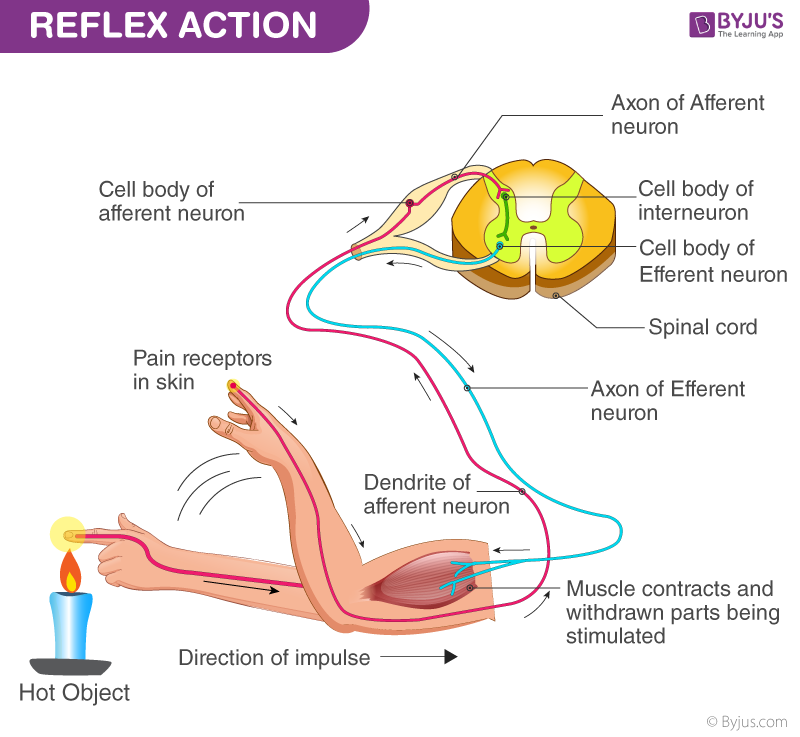
What is Reflex Action?
Reflex is an involuntary and sudden response to stimuli. It happens to be an integral component of the famed survival instinct.
Most of the common reflexes are a response to all the well-trained, accumulated knowledge of caution that we have internalized. It could be anything and ranges from the reflex action of abruptly withdrawing the hand as it comes in contact with an extremely cold or hot object. This action is termed as the reflex action. It has a subtle relation to instinct.
A point to be thought upon is that we all have our instincts differently depending on our past experiences and understanding. A reflex is a reaction triggered by this instinct. At times, we have no prior knowledge if the pan is hot or not. In other words, instinct has little to do with reflex.
Also Refer: Types of Reflex Actions
Labelled Diagram Of A Reflex arc

Reflex Arc Diagram
This labelled diagram of a reflex arc indicates the neural pathway controlling a reflex. It clearly indicates the route adapted when a stimulus occurs and how the reaction takes place.
From an evolutionary perspective, reflex action has played an important part in ensuring the survival of organisms as it has enabled quick reactions to certain situations where an organism’s life could be at stake.
The Action of Neuron
Two neurons dominate the pathway, afferent nerves (receptor) and the efferent nerves (effector or excitor).
Below is a brief description of the events that take place:
- Firstly, it begins with receptor detecting the stimulus or a sudden change in the environment, where the instinct again has a role to play. The stimulus is received from a sensory organ.
- Then, the sensory neuron sends a signal to the relay neuron.
- This is followed with the relay neuron sending the signal to the motor neuron.
- Further, the motor neuron sends a signal to the effector.
- The effector produces an instantaneous response, for example, pulling away of the hand or a knee-jerk reaction.
From the above explanations, it can be clearly summarized that the moment the afferent neuron receives a signal from the sensory organ; it transmits the impulse via a dorsal nerve root into the Central Nervous System. The efferent neuron then carries the signal from the CNS to the effector. The stimulus thus forms a reflex arc.
In a reflex action, the signals do not route to the brain – instead, it is directed into the synapse in the spinal cord, hence the reaction is almost instantaneous.
Also Refer: Nervous System: Control And Coordination
To learn more about reflex action or other related topics, visit BYJU’S Biology.
Reflex Action – Solved Questions
1. What is Reflex Action?
Reflex action is a sudden and involuntary response to stimuli. It helps organisms to quickly adapt to an adverse circumstance that could have the potential to cause bodily harm or even death. Pulling our hands away immediately after touching a hot or cold object is a classic example of a reflex action.
2. Briefly state the event that proceeds a stimulus in organisms.
- The first event begins with the receptor detecting a stimulus from a sensory organ. The stimulus could be in the form of pressure, temperature or chemicals.
- This is followed by the sensory neuron sending a signal to the relay neuron.
- The relay neuron then sends the signal to the motor neuron.
- The motor neuron sends a signal to the organ or a cell that acts to the stimuli called the effector.
- Finally, the effector produces an instantaneous response, such as a knee-jerk reaction.
3. What is a Reflex Arc?
A reflex arc is a pathway that controls a reflex.
Further Reading:
Recommended Video


IT IS A GOOD WEBSITE
Thanks for making a byjus learning app it’s really too good
The question that I asked is answered correctly so I want to thank the one who make this app
What happens if there is no system of reflex action in our nervous system?
is sweating a reflex action
yes sweating is a reflex action. When our body is overheated, we perspire and start sweating.
Keep it up guys
Awesome work! Everything here is accurate and well explained